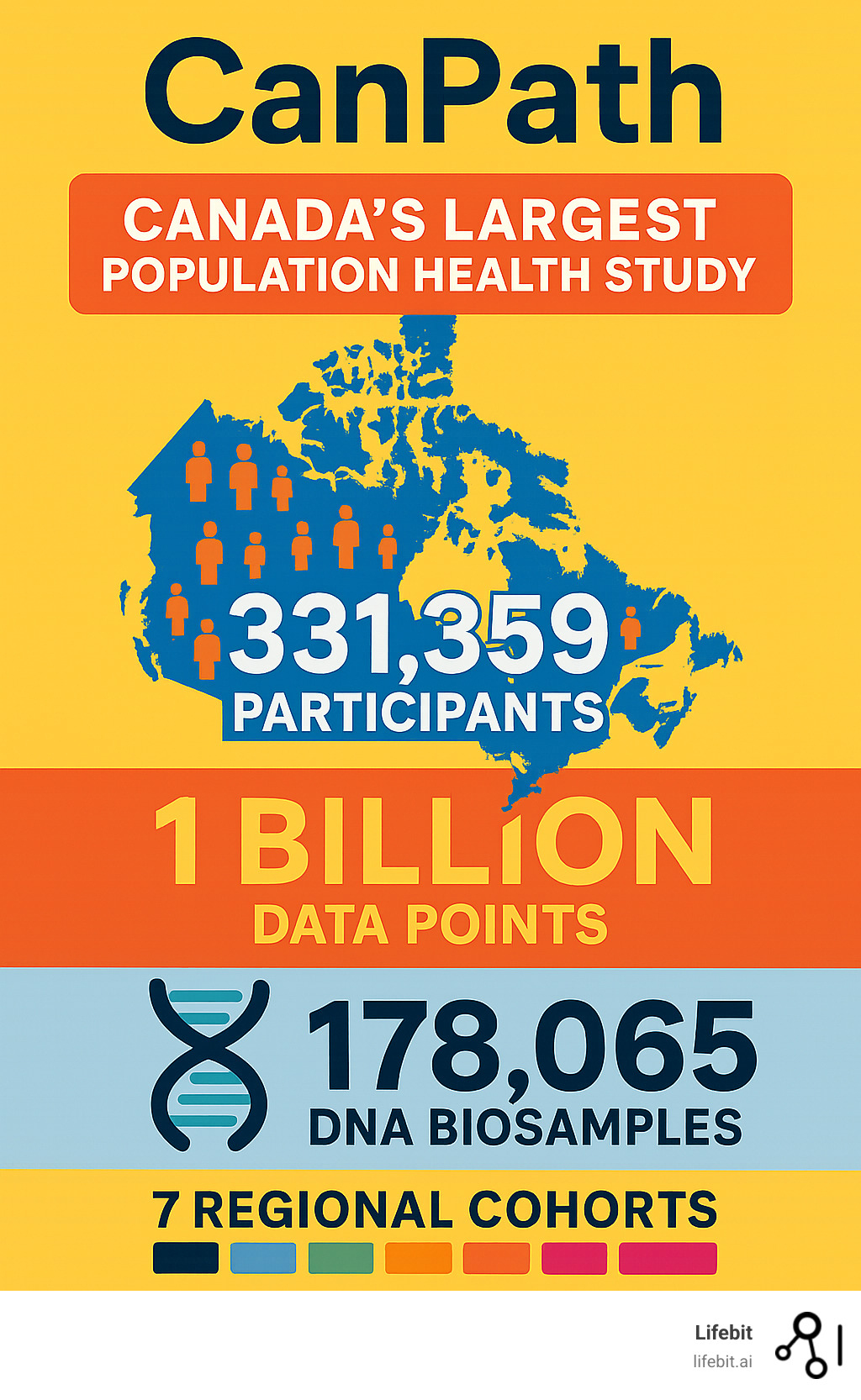CanPath to Better Health: What Canada’s Largest Study Means for You

What is CanPath? Unpacking Canada’s Largest Population Health Study
CanPath is Canada’s largest population health study, following over 330,000 Canadians to understand what causes chronic diseases and cancer. Here’s what you need to know:
- Full Name: Canadian Partnership for Tomorrow’s Health
- Scale: 331,359 participants (1 in 100 Canadians)
- Data: Over 1 billion data points and growing
- Biosamples: 178,065 DNA samples, 156,402 blood samples, 99,500 urine samples
- Mission: Study biology, behaviors, and environments to prevent disease
- Coverage: Seven regional studies across all 10 provinces
Think of CanPath as a massive health detective story. Instead of solving one crime, it’s trying to solve the mystery of why some people get sick while others stay healthy. The study tracks everything from participants’ DNA to their daily habits, creating a treasure trove of data that researchers worldwide use to develop better treatments and prevention strategies.
The numbers are staggering. With more than 2,800 different health and lifestyle measures collected from each participant, CanPath has supported over 190 research projects. These studies have led to breakthroughs in early cancer detection and helped us understand how our immune systems respond to COVID-19 vaccines.
As Maria Chatzou Dunford, CEO of Lifebit, I’ve worked extensively with genomics platforms that enable secure, federated analysis of sensitive health data like what CanPath collects. My experience in computational biology and health-tech has shown me how platforms like CanPath are revolutionizing our approach to population health research.

At its core, CanPath exists to “improve and accelerate research for a healthier Canada.” Its vision is to contribute to “a world without chronic disease and cancer” by providing a robust national platform for population-level health research, not just in Canada, but globally. This isn’t just about collecting data; it’s about changing it into actionable insights that can shape health policies and improve lives worldwide. You can learn more about their mission and scope directly from the source by visiting the About the CanPath study page.
The Treasure Trove of Data: Fueling Breakthroughs in Medicine
Think of CanPath as a vast digital library where each “book” tells the story of a Canadian’s health journey. But instead of dusty shelves, this treasure trove lives in secure servers, holding over a billion data points that are quietly revolutionizing how we understand disease and health.
What makes this collection so powerful? It’s not just the sheer volume of information – it’s the incredible breadth and depth. CanPath captures the full picture of human health, from the tiniest genetic variations to the neighborhoods where participants live. This comprehensive approach is what’s driving breakthroughs in health policy, personalized medicine, and early detection strategies across Canada and beyond.

The Four Pillars of CanPath Data
Every great structure needs a solid foundation, and CanPath‘s foundation rests on four essential pillars that work together to create a complete picture of health.
The first pillar is genomic data – essentially, the instruction manual written in our DNA. CanPath has collected an impressive 178,065 biosamples that serve as DNA source material. From these precious samples, researchers have completed genotyping on over 55,000 participants. This process uses SNP (Single Nucleotide Polymorphism) arrays to scan for hundreds of thousands of common genetic variations, revealing genetic patterns that might influence disease risk across large populations. The future looks even brighter with plans for whole genome sequencing (WGS), which will provide a much more detailed look at our genetic blueprints. Unlike genotyping, WGS reads nearly all of a person’s DNA, allowing researchers to identify rare genetic variants that may have a stronger impact on disease, opening up new avenues for understanding inherited conditions and developing targeted therapies.
Clinical data forms the second pillar, capturing the medical reality of participants’ lives. This includes health records linkage with provincial and national databases, allowing researchers to track health outcomes over decades. This linkage connects participant data to cancer registries, physician billing records, hospital discharge abstracts, and prescription drug databases. This creates a longitudinal health history, showing not just if a disease was diagnosed, but how it was treated and managed. In addition, physical measures like blood pressure, height, weight, body composition, grip strength, and lung function were collected at baseline, adding another layer of objective clinical insight to create a comprehensive health profile for each participant.
The third pillar focuses on behavioural data – all those daily choices that shape our health. Through detailed questionnaires, CanPath captures a wide array of lifestyle factors. This goes beyond simple diet and exercise habits to include detailed smoking history (including age of initiation and cessation), patterns of alcohol consumption, sleep duration and quality, and self-reported stress levels. Socio-economic factors are also woven into this picture, with data on education level, household income, and occupation. This is crucial because where we live and work often determines our health outcomes as much as our personal choices do, influencing everything from our access to healthy food to our exposure to occupational hazards.
Finally, environmental data completes the picture by examining our surroundings. Through the CANUE partnership (Canadian Urban Environmental Health Research Consortium), CanPath links participant postal codes with a rich dataset of environmental measures. This includes tracking long-term exposure to air pollution (like fine particulate matter PM2.5, nitrogen dioxide NO2, and ozone O3), measuring access to green spaces like parks, and even monitoring noise pollution from traffic and industry. Other metrics include neighborhood walkability scores, weather patterns, and proximity to different types of food retailers, all of which might affect health over time. This allows researchers to investigate how the world around us gets under our skin to influence disease risk.
How This Data Drives Cancer and Chronic Disease Research
All this data collection has a purpose: changing how we prevent, detect, and treat disease. The results are already impressive.
Advancing cancer research has been one of CanPath‘s most exciting success stories. Researchers are exploring fascinating connections, like how the oral microbiome – the community of bacteria living in our mouths – might be linked to colorectal cancer risk. Other studies have examined how breast cancer screening patterns changed during the COVID-19 pandemic, providing crucial insights for healthcare planning. These findings often get shared at events like the Canadian Cancer Research Conference, where researchers from across the country gather to discuss the latest findings. You can learn more about these important gatherings at the Canadian Cancer Research Conference information.
Tackling chronic diseases is equally important, especially as Canada’s population ages. CanPath data is helping researchers understand Alzheimer’s disease by exploring genetic links to brain changes that happen years before symptoms appear. Studies on healthy aging are particularly relevant since seniors are expected to make up nearly a quarter of Canada’s population by 2030. Researchers are also using the data to better understand heart disease patterns, the impact of shift work on chronic conditions, and the long-term health effects of the COVID-19 pandemic, including immune responses to vaccines and the prevalence of long COVID symptoms.
Perhaps most exciting is how this research is enabling personalized medicine. Instead of treating everyone the same way, doctors are beginning to develop custom treatments based on a person’s unique genetic makeup, lifestyle, and environment. Risk prediction models are becoming more accurate, potentially allowing doctors to intervene years before disease symptoms appear.
This is exactly the kind of secure, comprehensive data analysis that modern health research demands – and it’s changing our understanding of human health one data point at a time.
A United Front: CanPath’s Pan-Canadian Structure and Key Alliances
Imagine trying to coordinate a health study across a country that spans six time zones and covers nearly 10 million square kilometers. That’s exactly what CanPath has accomplished, and it’s no small feat. The secret to their success lies in a federated structure that brings together diverse regional voices while maintaining a unified national vision.
CanPath‘s pan-Canadian reach is more than just impressive geography – it’s essential for understanding how health varies across our vast country. A farmer in Saskatchewan faces different environmental challenges and lifestyle realities than a tech worker in Toronto, and these differences matter when we’re trying to solve the puzzle of chronic disease and cancer.
The magic happens through something called data harmonization. This meticulous process ensures that data collected in different provinces, sometimes using slightly different methods, can be standardized and compared. The Cross-Cohort Harmonization Project for Tomorrow (CHPT) takes this concept even further, bringing together 13 large cohort studies to create a searchable database covering over 2.5 million participants. It’s like having a master key that open ups health insights across the entire country.
The Seven Regional Cohorts
CanPath operates through seven regional powerhouses, each contributing their unique piece to the national health puzzle. This distributed approach recognizes that health doesn’t exist in a vacuum; environmental factors, cultural practices, and economic opportunities vary dramatically across Canada, and all of these influence our health.
- BC Generations Project: Hosted by BC Cancer, this cohort represents the province’s diverse population and leverages strong connections to the provincial healthcare system to track health outcomes.
- Alberta’s Tomorrow Project: As one of the most established cohorts, it has been collecting data for over two decades, providing a deep well of information on how lifestyle and genetics influence the risk of cancer and chronic disease.
- Healthy Future Sask: This cohort provides a vital perspective on health in a province with significant rural, remote, and Indigenous populations, whose health experiences can differ from those in urban centers.
- Manitoba Tomorrow Project: One of the newer members of the CanPath family, it is actively recruiting and contributing fresh data, ensuring the national picture of health remains current and comprehensive.
- Ontario Health Study: The largest of the regional cohorts, it reflects the immense diversity of Canada’s most populous province, capturing data from a wide range of ethnic and socio-economic groups.
- CARTaGENE: Based in Quebec, this cohort is invaluable for studying the health of a population with a unique genetic heritage and distinct cultural context, offering insights that might not be found elsewhere in Canada.
- Atlantic PATH (Partnership for Tomorrow’s Health): This study spans all four Atlantic provinces, a region with historically higher rates of certain cancers and chronic diseases, making it crucial for understanding regional health disparities.
Power in Partnership: The Collaborators Making It Happen
Behind CanPath‘s success is a network of partnerships that would make any project manager proud. These aren’t just handshake agreements – they’re deep, strategic alliances that make the impossible possible.
The Ontario Institute for Cancer Research (OICR) serves as CanPath‘s data guardian, hosting the massive national dataset in a secure, high-performance computing environment. Leveraging its world-class expertise in cancer informatics and data science, OICR ensures the data is not only safe but also analysis-ready for researchers. More about OICR shows how they’re revolutionizing cancer research infrastructure.
Perhaps one of the most powerful partnerships is with the Canadian Institute for Health Information (CIHI). This collaboration enables the linkage of CanPath‘s rich genomic and lifestyle data with CIHI’s comprehensive health services information. This includes national databases like the Discharge Abstract Database (hospitalizations), the National Ambulatory Care Reporting System (emergency and outpatient visits), and the Canadian Cancer Registry. Suddenly, researchers can see not just what makes someone sick, but their entire journey through the healthcare system.
The Health Data Research Network Canada (HDRN Canada) tackles one of research’s biggest headaches – navigating the complex world of data access across different provinces. Their Data Access Support Hub (DASH) acts as a single front door for researchers, streamlining the application process for multi-regional studies. This service is a game-changer, saving researchers months of administrative effort.
Canadian Partnership Against Cancer provides crucial national funding, recognizing CanPath as a cornerstone of Canada’s cancer control strategy. Meanwhile, the University of Toronto’s Dalla Lana School of Public Health provides the academic home base for the National Coordinating Centre, fostering the research ecosystem that turns data into findies.
As Prof. Adalsteinn Brown wisely noted, Canada has always had impressive health data assets, but sharing them across provincial boundaries has been like trying to connect puzzle pieces from different boxes. These partnerships are finally making those pieces fit together, creating a clearer picture of Canadian health than we’ve ever had before.
The Future is Federated: Secure Data Access and AI Innovation
When you’re dealing with health data from over 330,000 Canadians, security isn’t just important – it’s everything. CanPath understands this responsibility deeply, which is why they’ve built their entire approach around protecting participant privacy while still enabling groundbreaking research.
Think of it like a high-security vault that somehow still allows scientists to peek inside and make findies. The sensitive nature of health information means every access point, every analysis, and every data transfer must be bulletproof. CanPath achieves this through strict participant consent processes, rigorous ethical oversight, and cutting-edge technology that keeps data safe while making it useful.

How Researchers Access Data Securely
The old days of mailing data on hard drives or downloading massive files to local computers are long gone – and for good reason. Those methods created multiple copies of sensitive data, increasing the risk of breaches. Today’s gold standard is the Trusted Research Environment (TRE), a secure, remote platform where data can be analyzed but not removed.
CanPath recently launched a cloud-based TRE through their collaboration with Lifebit and Amazon Web Services. This isn’t just a minor upgrade – it’s a fundamental shift in how health research happens in Canada, based on a model of federated data analysis.
Here’s what makes this platform special: researchers can now analyze data where it lives instead of moving it around. The data stays put in its secure home at the Ontario Institute for Cancer Research, while approved researchers bring their analytical tools and code to it. This federated approach dramatically reduces security risks while making research faster and more efficient. The CanPath Access Portal streamlines the entire process. Researchers submit applications that go through a thorough feasibility assessment and review by an access committee. Once approved, they are granted access to the secure TRE, where they can run complex analyses without ever downloading sensitive information. Every action within the TRE is logged, creating a complete audit trail for maximum accountability.
Prof. Victoria Kirsh, Executive Scientific Director of CanPath, calls this shift a “game-changer for health research in Canada.” She explains that it allows researchers to “tackle complex health questions like never before – it’s effective, efficient, and accessible.” The platform lets scientists upload their own analytical tools and develop new methodologies right within the secure environment.
This collaboration represents a major advancement in Canadian research infrastructure. You can learn more about the technical details and impact of this partnership here: More info about Lifebit’s collaboration with CanPath & AWS.
Emerging Opportunities for CanPath
CanPath isn’t resting on its impressive achievements. The future holds even more exciting possibilities as new technologies mature and research methods evolve.
Artificial Intelligence and machine learning are natural partners for CanPath‘s massive datasets. With over a billion data points, the study provides ideal training grounds for AI models that can spot patterns invisible to human researchers. This moves us beyond traditional analysis toward predictive modeling. For example, AI can be used to develop sophisticated polygenic risk scores, which combine the effects of thousands of genetic variants to predict an individual’s risk for diseases like breast cancer or heart disease. This could lead to personalized screening schedules custom to an individual’s genetic risk.
The integration of whole genome sequencing represents another major leap forward. While genotyping provides a snapshot of common genetic variants, WGS will provide an incredibly detailed genetic picture for a large subset of the cohort. This is made possible by a substantial $6.2 million grant from Genome Canada for the “Enabling Personalized Genomics in Health with the CanPath Data Safe Haven.” This deeper genetic understanding will open up research into rare variants that may cause disease, helping to diagnose rare conditions and identify new drug targets. Details on the Genome Canada grant provide more information about this significant investment.
Global collaboration is increasingly important as health challenges cross borders. CanPath is positioned alongside major international initiatives like the UK Biobank and the US All of Us Research Program. It is an active member of the International HundredK+ Cohorts Consortium (IHCC), which brings together large-scale population studies from around the world. This global perspective ensures that insights from Canadian participants can benefit people everywhere, while Canadian researchers can participate in powerful meta-analyses that combine data from millions of people worldwide.
The combination of secure infrastructure, advanced analytics, and international partnerships creates an environment where CanPath can tackle increasingly complex health questions. It’s an exciting time for population health research, and CanPath is leading the way.
Frequently Asked Questions about CanPath
You probably have questions about CanPath – and that’s completely natural. This massive health study touches on some pretty important topics like privacy, participation, and what it all means for everyday Canadians. Let’s tackle the most common questions we hear.
What is the main goal of the CanPath study?
Think of CanPath as Canada’s biggest health detective story. The main goal is simple but powerful: understand why some people get sick while others stay healthy.
By following over 330,000 Canadians for many years, CanPath studies how our genetics, environment, lifestyle, and daily behaviors all work together to influence our health. It’s not just about collecting information – it’s about turning that data into real answers that can help prevent chronic diseases and cancer.
The ultimate vision? A world without chronic disease and cancer. That might sound ambitious, but with over 1 billion data points and growing, CanPath is already making it happen. The insights from this study help develop better treatments, inform health policies, and advance personalized medicine that’s custom specifically to you.
How does CanPath protect participant privacy?
Privacy isn’t an afterthought for CanPath – it’s built into everything they do. And honestly, it has to be. When you’re dealing with the health information of 1 in 100 Canadians, security becomes absolutely critical.
Here’s how they keep your information safe: All personal identifiers are completely removed from any data that researchers see. Your name, address, and other identifying details never make it to the research side. It’s like getting a library book with the cover removed – researchers can read the story, but they can’t tell whose story it is.
Every single research project goes through rigorous ethics committee approval. No exceptions. Researchers can’t just decide they want to use CanPath data and dive in – there’s a thorough review process to ensure the research is legitimate and beneficial.
The real game-changer is the Trusted Research Environment (TRE). This is where Lifebit’s technology really shines. Instead of researchers downloading data to their own computers, they analyze everything within a secure, cloud-based environment. The data never leaves its safe home – researchers come to it, not the other way around. It’s like having a secure vault where you can work with the contents, but nothing can be taken out.
Can I still join the CanPath study?
This is one of the most heartwarming questions we get – Canadians who want to contribute to this incredible research effort. While the main recruitment phase is complete, the door isn’t entirely closed.
Some of the seven regional cohorts might still have opportunities for new participants. Each region – from the BC Generations Project to Atlantic PATH – operates a bit differently and may have specific research needs that require additional participants.
Your best bet is to check the official CanPath website or reach out to your specific regional cohort directly. They’ll have the most up-to-date information about whether they’re accepting new participants in your area.
Even if you can’t join right now, the research you’re reading about today might benefit your children or grandchildren tomorrow. That’s the beautiful thing about population health studies – they create ripple effects of knowledge that improve health for generations to come.
Conclusion: What CanPath’s Research Means for Your Health
When you look at CanPath, you’re not just seeing a research study – you’re witnessing Canada’s boldest bet on the future of health. This massive undertaking represents something truly special: a national commitment to understanding why we get sick and, more importantly, how we can stay healthy.
The impact is already happening. Right now, researchers are using CanPath‘s treasure trove of data to develop personalized medicine approaches that could change how your doctor treats you. Instead of one-size-fits-all treatments, we’re moving toward care custom specifically to your genetic makeup, lifestyle, and environment.
Early detection is getting smarter too. Studies using CanPath data are revealing new ways to spot diseases before symptoms appear, when treatment is most effective. For cancer and chronic diseases like heart disease and Alzheimer’s, this early warning system could be life-changing.
But here’s what excites us most: the power of population data is just beginning to be releaseed. As artificial intelligence becomes more sophisticated and platforms like Lifebit’s federated technology make data analysis more secure and efficient, the findies will accelerate. We’re talking about custom treatments designed for you, risk predictions that help you make better health choices, and prevention strategies that could stop diseases in their tracks.
The hope for preventing disease isn’t just wishful thinking anymore – it’s backed by real data from real Canadians. CanPath is showing us that when we combine cutting-edge technology with rigorous science and ethical data management, we can build a healthier Canada and contribute to global health benefits that reach far beyond our borders.
This is the future of medicine unfolding before our eyes. Every data point collected, every genome sequenced, every environmental factor measured brings us closer to a world where chronic disease and cancer are not inevitable parts of aging, but preventable conditions we can outsmart.
At Lifebit, we’re honored to be part of this journey, providing the secure, federated platform that makes this groundbreaking research possible. CanPath proves that when we protect privacy while enabling findy, incredible things happen.
Learn how Lifebit empowers data providers like CanPath to open up the full potential of their valuable datasets, building a healthier tomorrow one secure analysis at a time.


